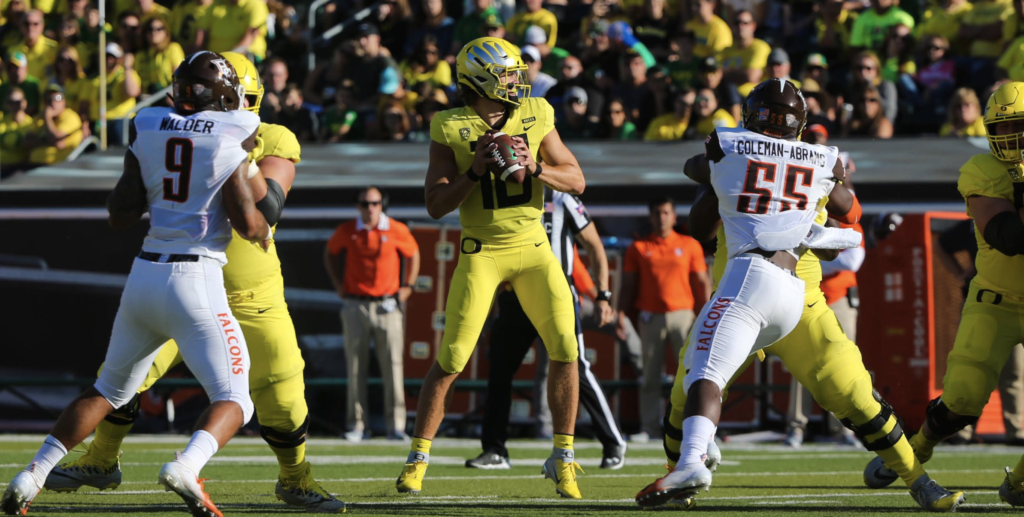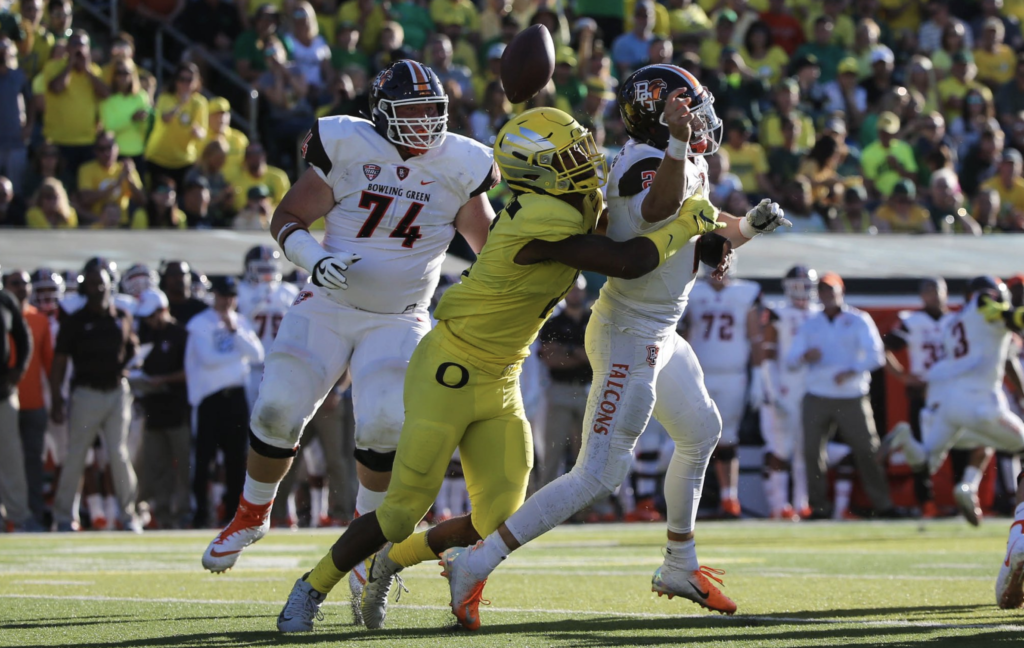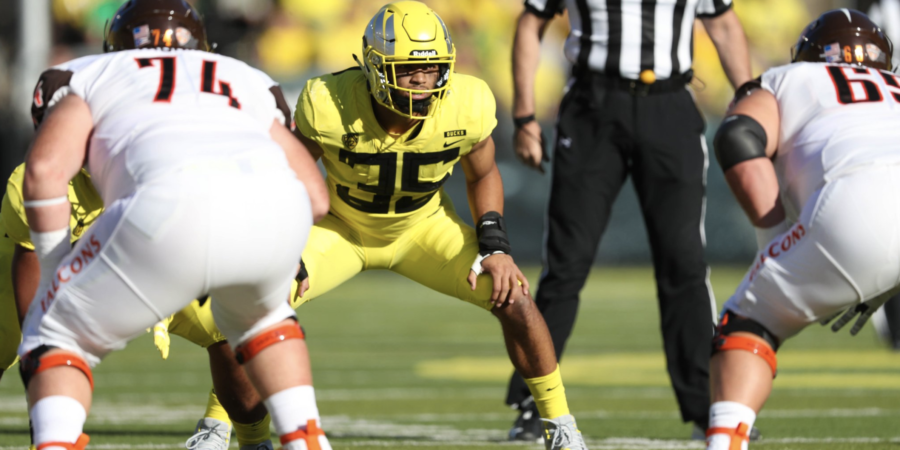It’s not often that there are many nits to pick following a 58-24 victory, but for Oregon head coach Mario Cristobal and the Ducks, there will be plenty to chew on, digest, and ultimately remedy once preparations for next Saturday’s game versus Portland State begin.
In short, Oregon’s 34-point win in their season opener versus Bowling Green confirmed a few things we already knew (e.g. Justin Herbert and Troy Dye are really good), posed a few questions we didn’t quite know to ask (e.g. are drops going to be a bugaboo for Oregon’s receivers this season?), and left unanswered some things we openly wondered about during the offseason (e.g. who emerges as this team’s lead back?).
To makes sense of it all, WFOD offers up its prevailing thoughts and takeaways from the Ducks’ victory over Bowling Green Saturday night inside Autzen Stadium.

1. As Justin Herbert goes, so goes Oregon
Admittedly, that’s not saying much, but even compared to last season, it’s clear that quarterback Justin Herbert is the catalyst for the Ducks in 2018. A year ago, Herbert shared that title with an all-timer in record-breaking running back Royce Freeman. With Freeman graduated to the NFL, Herbert is now the one who shoulders the lion’s share of the load for the Ducks offensively. And versus Bowling Green Saturday, Herbert demonstrated that he’s perfectly fine assuming that kind of responsibly.
Though the stat line will say that Herbert completed less than 50 percent of his passes (47.6 to be exact), anyone who watched the game saw that there were a handful of plays that Herbert’s receivers simply failed to make. Still, the Eugene native was tremendously effective in showing why many consider him to be the nation’s best quarterback. Herbert finished the game with 281 yards and five touchdowns through the air, while adding 41 yards and another score via the ground, demonstrating both the athleticism and the big arm (averaging 28.1 yards per completion vs. Bowling Green) that has NFL scouts salivating. While he will be credited with two interceptions, fair arguments can be made that explain away those miscues, such as a receiver running a poor route and an ill-fated pass that was deflected and intercepted. As long as Herbert is healthy and upright, Oregon will go as far as he’s able to take them.
All six of Justin Herbert’s touchdowns in tonight’s win over Bowling Green. #GoDucks pic.twitter.com/F9JObKuixP
— Oregon Football (@oregonfootball) September 2, 2018
2. Oregon’s pass protection was on point
For as good as Herbert looked, major credit goes to the Oregon offensive line for the terrific job they did in keeping their quarterback clean. Only twice Saturday did Bowling Green register a hurry on Herbert, as the starting group (from left to right) of Penei Sewell, Shane Lemieux, Jake Hanson, Dallas Warmack, and Calvin Throckmorton were outstanding all game long. The inclusion of Sewell was particularly noteworthy, as the highly-touted true freshman was the first true freshman offensive lineman to start in a season opener since Lee Gundy did it in 1997 vs. Arizona.
3. Drops, sloppy offensive execution raises potential concerns
Aside from the exemplary play of Herbert, the overall performance of the Oregon offense was largely inconsistent and uneven. No player summed up the yin and yang nature of the Oregon offense on Saturday more than sophomore receiver Jaylon Redd. Though he would finish the game with two catches for 81 yards and two touchdowns, Redd was plagued by drops (we counted at least two) and an apparent lack of sustained focus, which manifested itself in the form of an incomplete route that directly led to a Herbert interception in the fourth quarter. However, Redd was far from the only Oregon receiver to struggle catching the ball Saturday, as sophomore Johnny Johnson also had a pair of notable drops to go along with a touchdown of his own.
Communication and the execution of assignments out of the Pistol formation also seemed to be a sporadic issue for the Ducks on Saturday. Specifically, there were a few instances of backs going the wrong direction on designed runs and play fakes, which resulted in negative plays for the offense. The Ducks still gained over 500 yards of total offense (504) for the ninth straight time in a home opener, and in his first game as the Oregon play-caller, Marcus Arroyo appeared at ease pulling the offensive levers, often putting Herbert and the offense in advantageous positions to score points. Yet, the offense failed on multiple occasions – particularly late in the game – to deliver a final knockout blow. Even after Herbert re-entered the game in place of backup quarterback Braxton Burmeister late in the third quarter, the Ducks’ supporting cast struggled to help close the game out in convincing fashion. This will be something to take note of moving forward.

4. After a slow start, the Duck defense gained momentum
There were more than a few sweaty palms and nervous glances at the Autzen Stadium scoreboard when the Ducks fell behind 10-0 with roughly five minutes to go in the first quarter. The offense choked and sputtered on its first couple possessions, while the defense appeared disjointed and flat-flooted to start the game; a mild surprise considering the amount of returning talent for the Ducks on that side of the ball. Yet, that was about as much as the Falcons would threaten. From that point on, the defense clamped down, while the offense rattled off 37 unanswered points before Bowling Green found the end zone just before halftime.
In particular, the Oregon pass rush seemed to pick up considerably after Justin Hollins’ second quarter sack and forced fumble was recovered by the Ducks deep in Falcons territory, and quickly converted into points just a few plays later. The opportunistic play would continue in the second half, as Ugo Amadi’s 38-yard pick six extended Oregon’s lead to 44-17 early in the third quarter, effectively putting the game out of reach. In total, the Ducks forced three turnovers on the day, converting each to a touchdown. Though Oregon allowed Bowling Green running back Andrew Clair (113 yards rushing) and wide receiver Scott Miller (13 catches for 166 yards and two touchdowns) to have impressive individual performances, they held the rest of the Bowling Green offense in check. There’s undoubtedly work to be done here, but for the most part, the defense came through with an encouraging all-around performance.
HIGHLIGHT | The Ducks start the second half with a pick six! #GoDucks pic.twitter.com/CDok3hwm16
— Oregon Football (@oregonfootball) September 2, 2018
5. We still don’t know who Oregon’s lead back is
Despite finishing fall camp as the No. 1 running back on the depth chart, the Tony Brooks-James era at Oregon is off to a rather non-descript start. His 53-yard reception aside, Brooks-James did little to separate himself from the competition that’s currently stacked behind him, rushing for 27 yards on only five carries Saturday. The good news for Brooks-James is that none of his backups did much to steal the spotlight. CJ Verdell led the Ducks on the ground with 51 yards on 13 carries, while Darrian Felix (8 carries, 38 yards) and Travis Dye (7 carries, 37 yards) were the next highest ground-gaining running backs. Cyrus Habibi-Likio had one carry for five yards which ended in a touchdown, while Taj Griffin had one carry for four yards. Griffin, however, would provide the biggest play of the day with his 83-yard catch and run from Herbert in the third quarter. As a team, the Ducks rushed for 212 yards versus Bowling Green, though it was far from a remarkable overall performance. Perhaps the by-committee approach will prove successful for Oregon this season, but to count on that feels like a stretch, particularly once the schedule increases in difficulty. It’s definitely not time to hit the panic button, but the longer this team goes without a definitive identity on the ground, the more Duck fans should worry.
6. Troy Dye is as good a linebacker as there is in the Pac-12
Again, we’re not exactly sticking our neck out with this statement, but it’s hard to imagine there are many Pac-12 linebackers – or defenders, in general – that are as disruptive and impactful as Dye. On Saturday, Dye was seemingly everywhere, finishing with eight tackles, one interception, and one pass breakup that should have been a second interception if not for the ball slipping through his hands. Herbert is in a class all his own as it relates to his importance to this team, but Dye isn’t far behind, as he once again proved why he’s the unquestioned heart and soul of the Oregon defense. It was a very impressive season opener for the guy who was voted by his teammates as the team’s most outstanding defensive player a year ago.
HIGHLIGHT | Troy Dye makes a fantastic sideline interception. #GoDucks pic.twitter.com/xCIt1PVB20
— Oregon Football (@oregonfootball) September 2, 2018
7. Penalty Killers
After leading the nation in both penalties per game (9.4) and penalty yards per game (88.3) in 2017, the Ducks appeared vastly improved in this department on Saturday, as Oregon was flagged only three times for 35 yards. This is an encouraging sign of improved discipline after the Ducks seemingly mastered the art of self-inflicted wounds a season ago.
News and notes:
- Following the game it was reported that there were two injuries of note – one to redshirt sophomore tight end Cam McCormick, and one junior linebacker La’Mar Winston. Of McCormick, Cristobal said, “He hurt his leg and got X-rays. We think it might be a pretty significant injury.” More details to come there. Of Winston, Cristobal said he and couple of other guys are getting checked out. “They took some pretty good shots,” said Cristobal. “We always have to check guys whether it be for a concussion, a shoulder injury…Those guys are being checked and as soon as we get true word on what that is, we’ll get that to you.”
- Ugo Amadi’s interception return for a touchdown is the third straight game (dating back to last season) that the Oregon defense has scored a touchdown
- Justin Herbert surpassed 4,000 career passing yards, equaling the fastest to reach the mark in terms of games (18 – Marcus Mariota) and starts (16 – Joey Harrington)
- Sophomore nose guard Jordon Scott set career-highs in tackles (7) and tackles for loss (1.5) versus Bowling Green. He did so primarily with an injured hand, which was heavily taped throughout most of the game.


Sketchy play at the receiver spot, running back by committee and inexperience at the cornerback spots are going to stop Oregon from fully realizing their potential.
I’ve never heard of a team being very successful having more than 2 running backs getting the majority of carries. Running backs need to develop a rhythm and this is going to hurt us. Very disappointed in how TBJ looked. Looked slow and indecisive compared to years past when he would come in to spell Freeman.
Oregon has never been so thin at WR. Outside of Michell I don’t trust the receivers to make the difficult catch. Contrast this to Washington and other elite teams I watched on Saturday where it looked like the WR’s were catching anything thrown their way.
Finally, Thomas Graham is solid but outside of him we really have no one to lock down on the outside. Lenoir is okay and then we go to 2 true freshman in McKinley and Hailassie, both of which looked outmatched by BG’s receivers.
For those reasons I don’t see the team being great, but they will be good due to Herbert, the OL and easy schedule. I thought 10 wins was possible before the season started but I’m thinking more realistic is 7-9 wins.
Nice recap; hopefully Winston is back for Stanford. Why does Oregon need to identify a lead back? What’s the issue to a RB committee? Especially since each RB seems to bring different abilities. Also, someone needs to tell Herbert to stop running the ball – unless it’s a critical situation against a tough opponent. We’d rather punt the ball from the 1-yard line then to have Herbert run it in
Thanks for the note, Kris!
There’s nothing wrong with a RB by-committee approach, especially over these first three games where the Ducks can kind of afford to tinker and experiment with certain guys in certain situations. Eventually though they’ll want to settle on two, maybe three guys they know they can count on, particularly once the competition starts to really ramp up in a few weeks.
The issue with a by-committee approach (especially one involving six different players) is that it doesn’t allow any of the RBs to find a rhythm and play with confidence…it’s not totally unlike rotating a different QB every other series. Football is a momentum game at the end of the day. Having two to three guys who are playing confidently and not necessarily looking over their shoulder to see when they’re going to get pulled is a lot better than having six guys who all show a little something, but never get on track because they know they won’t be in the game for long.
Now isn’t the time to panic, but I think there will be some valid concern if a pecking order isn’t established by the time the Stanford game rolls around.